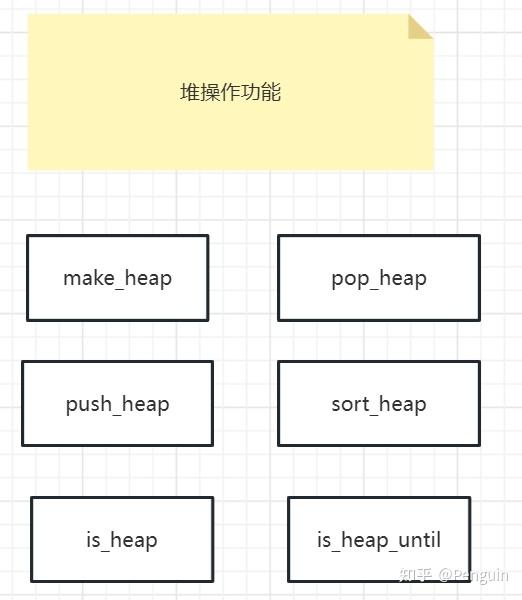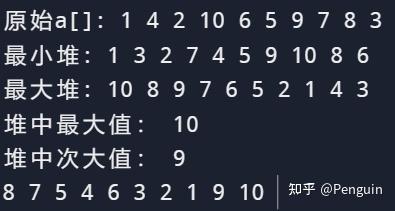|
|

主要函数
- make_heap():从序列构造堆。
- pop_heap():从堆中弹出元素。
- push_heap():向堆中加入元素。
- sort_heap():给堆排序。
- is_heap():判断序列是否是一个有效的堆
- is_heap_until():判断序列是否是一个有效的堆,返回一个迭代器
make_heap()函数模板原型为:
template<class RandomAccessIterator>
void make_heap (RandomAccessIterator first, RandomAccessIterator last);
template<class RandomAccessIterator, class Compare>
void make_heap(RandomAccessiterator first, RandomAccessIterator last, Compare comp) ;make_heap()函数将[first,last)区间构造成一个堆。第一个版本使用<来确定顺序,而第二个版本使用comp比较对象。
例子:
#include <iostream>
#include <vector>
#include <algorithm>
#include <iterator>
using namespace std;
int main(){
int a[] = {1, 4, 2, 10, 6, 5, 9, 7, 8, 3};
cout<< &#34;原始a[]: &#34;;
copy(a, a + 10, ostream_iterator<int>(cout, &#34; &#34;));
cout<< endl;
vector<int>v1(a, a + 10);
make_heap(v1.begin(), v1.end(), greater<int>());
cout<< &#34;最小堆: &#34;;
copy(v1.begin(), v1.end(), ostream_iterator<int>(cout, &#34; &#34;));
cout<< endl;
vector<int>v2(a, a + 10);
make_heap(v2.begin(), v2.end(), less<int>());
cout<< &#34;最大堆: &#34;;
copy(v2.begin(), v2.end(), ostream_iterator<int>(cout, &#34; &#34;));
return 0;
}

建最小堆用的二元函数是greater,不是 less;建最大堆用的二元函数是less,而不是greater。与常规用到的二元函数语义正好相反。
pop_heap()函数模板原型为:
template<class RandomAccessIterator>
void pop_heap(RandomAccessIterator first, RandomAccessIterator last);
template<class RandomAccessIterator, class Compare>
void pop_heap (RandomAccessIterator first, RandomAccessIterator last, Compare comp) ;pop_heap()函数假设[first, last)区间是一个有效堆,并将位置last -1处的值与first处的值进行交换使[first, last - 1]区间成为一个有效堆。第一个版本使用<来确定顺序,而第二个版本使用comp比较对象
例子:
#include <iostream>
#include <vector>
#include <algorithm>
#include <iterator>
using namespace std;
int main(){
int a[] = {1, 4, 2, 10, 6, 5, 9, 7, 8, 3};
cout<< &#34;原始a[]: &#34;;
copy(a, a + 10, ostream_iterator<int>(cout, &#34; &#34;));
cout<< endl;
vector<int>v1(a, a + 10);
make_heap(v1.begin(), v1.end(), greater<int>());
cout<< &#34;最小堆: &#34;;
copy(v1.begin(), v1.end(), ostream_iterator<int>(cout, &#34; &#34;));
cout<< endl;
vector<int>v2(a, a + 10);
make_heap(v2.begin(), v2.end(), less<int>());
cout<< &#34;最大堆: &#34;;
copy(v2.begin(), v2.end(), ostream_iterator<int>(cout, &#34; &#34;));
cout<< endl;
pop_heap(v2.begin(), v2.end());
cout<< &#34;堆中最大值: &#34; ;
cout<< *(v2.end() - 1) << endl;
pop_heap(v2.begin(), v2.end() - 1);
cout<< &#34;堆中次大值: &#34; ;
cout<< *(v2.end() - 2) << endl;
copy(v2.begin(), v2.end(), ostream_iterator<int>(cout, &#34; &#34;));
return 0;
}

可以看到,vector中存在脏数据,所以在使用pop_heap时要考虑数据的有效长度
push_heap()函数模板原型为:
template<class RandomAccessIterator>
void push_heap(RandomAccessIterator first, RandomAccessIterator last);
template<class RandomAccessIterator, class Compare>
void push_heap(RandomAccessIterator first, RandomAccessIterator last, Compare comp);push_heap()函数假设[first, last - 1)区间是一个有效的堆,并将last - 1位置(即被假设为有效堆的区间后面的一个位置)上的值添加到堆中,使[first,last)区间成为一个有效堆。第一个版本使用<来确定顺序,而第二个版本使用comp比较对象。
sort_heap()函数模板原型为:
template<class RandomAccessIterator>
void sort_heap (RandomAccessIterator first, RandomAccessIterator last);
template<class RandomAccessIterator, class Compare>
void sort_heap(RandomAccessIterator first, RandomAccessIterator last, Compare comp) ;sort_heap()函数假设[first,last)区间是一个有效堆,并对其进行排序。第一个版本使用<来确定顺序,而第二个版本使用comp比较对象。
is_heap()函数模板原型为:
template<class RandomAccessIterator>
bool is_heap(RandomAccessiterator first, RandomAccessIterator last);
template<class RandomAccessIterator, class Compare>
bool is_heap(RandomAccessIterator first, RandomAccessIterator last, Compare comp) ;如果区间[first, last]是一个有效的堆,函数 is_heap()将返回true,否则返回false。第一个版本使用<来确定顺序,而第二个版本使用comp比较对象。
is_heap_until()函数模板原型为:
template<class RandomAccessIterator>
RandomAccessIterator is_heap_until(RandomAccessIterator first, RandomAccessIterator last) ;
template<class RandomAccessIterator, class Compare>
RandomAccessIterator is_heap_until(RandomAccessIterator first, RandomAccessIterator last, Compare comp) ;如果区间[first, last)包含的元素少于两个,则返回last;否则返回迭代器it,而区间[first, it)是一个有效的堆。第一个版本使用<来确定顺序,而第二个版本使用comp 比较对象。
例子:
#include <iostream>
#include <vector>
#include <algorithm>
#include <iterator>
using namespace std;
template<class T, class Pred = less<T>>
class MyHeap{
Pred pr;
vector<T> v;
int ValSize;
public:
MyHeap(T t[], int nSize):v(t, t + nSize){
ValSize = nSize;
if(!is_heap(v.begin(), v.begin() + ValSize)){
make_heap(v.begin(), v.begin() + ValSize, pr);
}
}
bool Insert(const T& t){
v.push_back(t);
ValSize++;
push_heap(v.begin(), v.begin() + ValSize, pr);
return true;
}
bool Remove(T& result){
if(ValSize == 0) return false;
pop_heap(v.begin(), v.begin() + ValSize, pr);
result = *(v.begin() + ValSize -1);
ValSize--;
return true;
}
bool Sort(){
if(is_heap(v.begin(), v.begin() + ValSize)){
sort_heap(v.begin(), v.begin() + ValSize);
return true;
}
return false;
}
bool IsEmpty(){
return ValSize == 0;
}
void Display(){
copy(v.begin(), v.begin() + ValSize, ostream_iterator<int>(cout, &#34; &#34;));
}
};
int main(){
int a[] = {1, 4, 2, 10, 6, 5, 9, 7, 8, 3};
MyHeap<int, greater<int>>m(a, 10);
cout<< &#34;原始堆: &#34;;
m.Display();
cout<< endl;
m.Insert(0);
cout<< &#34;插入0后为: &#34;;
m.Display();
cout<< endl;
int result;
m.Remove(result);
cout<< &#34;堆中最小值为: &#34; << result << endl;
return 0;
}
 |
|